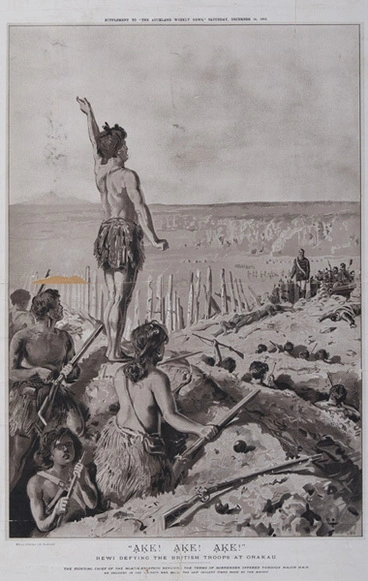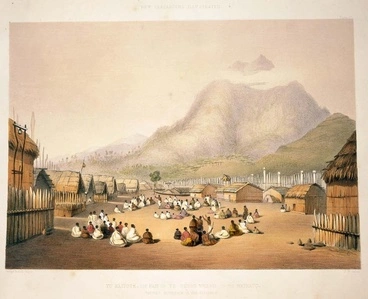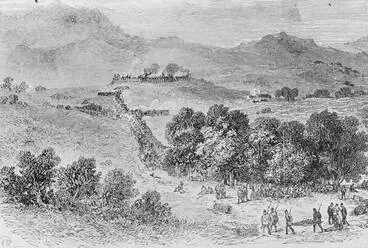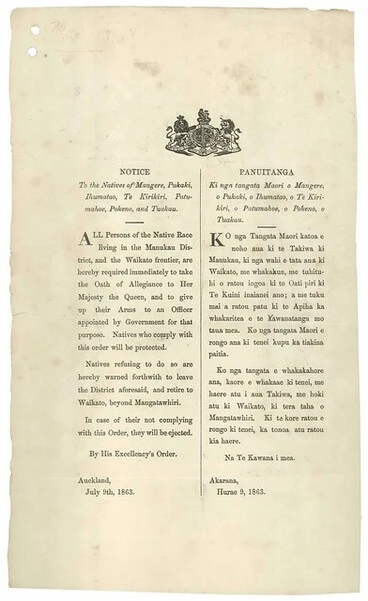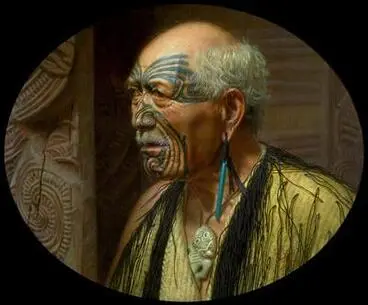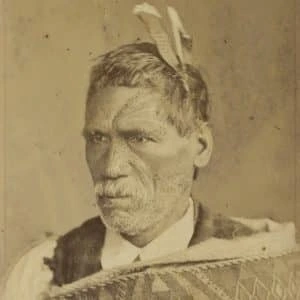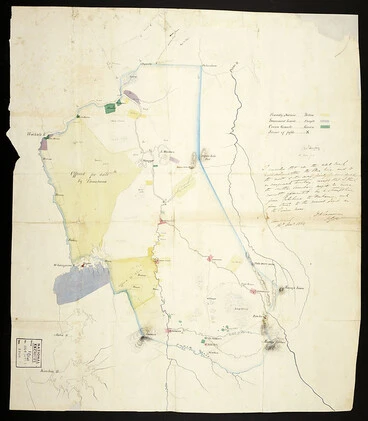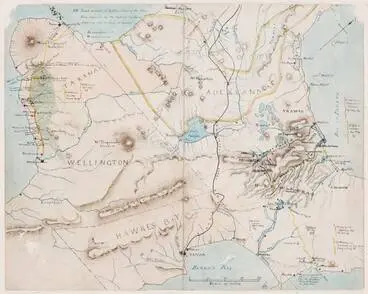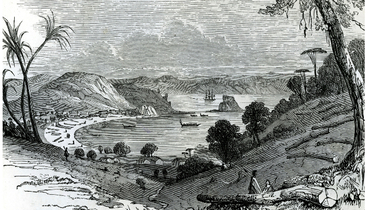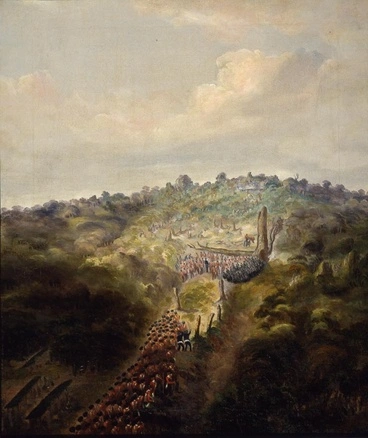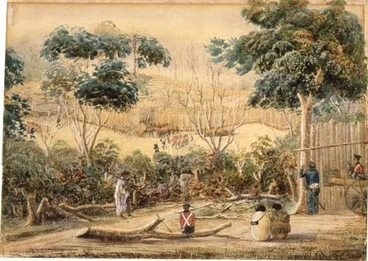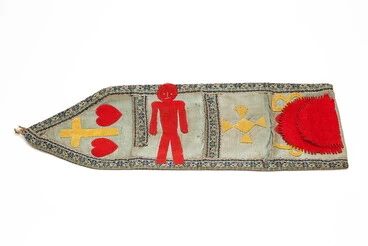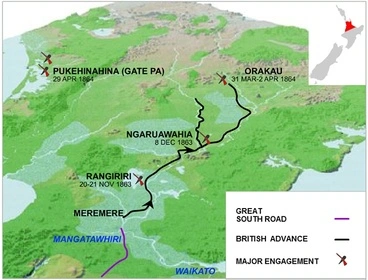War in the Waikato 1863-65
A DigitalNZ Story by National Library of New Zealand Topics
Rangiriri, Rangiaowhia and Ōrākau are sites where some of the major Waikato battles were fought during the New Zealand Wars | Ngā Pakanga o Aotearoa. This topic covers some of the reasons for these conflicts, the battles and their lasting impact on Waikato iwi. SCIS no. 1966016
Māori prisoners captured at Rangiriri
Twenty-four Māori men (some obscured) are standing or seated mainly aboard the prison ship (hulk) Marion anchored in the Auckland Harbour. They are dressed in a mixture of Māori and European clothes. A news clipping surrounding the photograph is headed; 'Escape of the Māori prisoners of war, 200 in number' copied from the Weekly News of 17 September 1864.
Alexander Turnbull Library
Hamley, Joseph Osbertus, 1820-1911 :Meremere, Waikato [1864]
Alexander Turnbull Library
"Ake! Ake! Ake!" Rewi defying the British troops at Orakau.
This artistic depiction shows Rewi Maniapoto standing defiantly during the siege of Ōrākau. Rewi was the famous Ngāti Maniapoto leader and supporter of the Kiingitanga movement. In March 1864 the British troops surrounded the Ōrākau Pā which held Rewi Maniapoto and around 300 Māori defenders, which included women. General Cameron knew the conditions inside the pā were deteriorating and called upon the Māori to surrender, to which Rewi replied the famous words: 'Ka whawhai tonu mātou, Āke! Āke! Āke!' (we will fight on forever and ever). Ōrākau was to be the last major battle of the Waikato war.
University of Otago
Rewi's last stand?
Manatū Taonga, the Ministry for Culture and Heritage
Rewi’s Last Stand
Services to Schools
The Waikato War of 1863-64 – A guide to the main events and sites
Services to Schools
RNZ: NZ Wars: Stories of Tainui
Services to Schools
The Waikato-Tainui claim
Manatū Taonga, the Ministry for Culture and Heritage
Waikato-Tainui Raupatu: Deeds of Settlement
Services to Schools
Ōrākau - March 1864
DigitalNZ
War in Waikato
Services to Schools
Ōrākau, famed battle site - Roadside Stories
Services to Schools
War and its aftermath
Manatū Taonga, the Ministry for Culture and Heritage
Proclamation requiring Māori to take an Oath of Allegiance, 9 July 1863
Manatū Taonga, the Ministry for Culture and Heritage
The Palace Ngaruawahia N.Z.
Auckland War Memorial Museum Tāmaki Paenga Hira
Rahui Papa - Waikato Land Wars
Radio New Zealand
Chapter XL. — The Waikato War - The Life and Times of Sir George Grey, K.C.B.
Victoria University of Wellington
Pāterangi - January 1864
DigitalNZ
Secretary, Native Department - War in Taranaki and Waikato and King Movement
Alexander Turnbull Library
Confiscated territory after the Maori Wars, in the Waikato, 1864
Archives New Zealand Te Rua Mahara o te Kāwanatanga
THE VOLUNTEER MILITIA MOVEMENT. (Southland Times, 17 October 1863)
National Library of New Zealand
Meremere - October 1863
DigitalNZ
Construction of the Great South Road to Waikato, Pokeno Hill
This road (the Great South Road), being constructed by soldiers was part of Governor George Grey’s plan to invade the Waikato. Waikato Māori remained determined not to sell their land, but Grey was equally determined to break their resistance. He claimed that Waikato Māori were conspiring to attack settlers and sent his army (using this road) on 12 July 1863. The fighting that followed over the next nine months spread to other parts of the North Island. As a punishment for their supposed rebellion Waitako Māori had their huge tracts of the fertile lands confiscated.
Alexander Turnbull Library
In memory of Orākau
This report is about the bravery and courage of Māori at the Battle of Ōrākau in March 1863, and the commemoration programme that took place fifty years later. On 1 April 1914, a monument was unveiled which had on one side the name of General Carey – the British commander of the historic engagement, and on the other side the name of the brave Māori chief Rewi Maniopoto and his memorable words of defiance. In 2013 and 2014, the 150th anniversary commemoration of the battles of Waikato War took place in Waikato and Tauranga. Funded by the government, it was organised by iwi and local communities and coordinated by Ngā Pae o Maumahara.
National Library of New Zealand
Ohaupo redoubt & Forest Ranger camp
This picture of a Forest Rangers camp was probably drawn by Gustavus Ferdinand von Tempsky – a Prussian born soldier who came to New Zealand in 1862 to prospect for gold in the Coromandel. Von Tempsky commanded the legendary Forest Rangers, a colonial group of volunteers who were believed to have the ability to match the bush fighting skills of Māori. The campaigns he fought in the New Zealand Wars were to become an inspiration for many of his paintings. Even though he was considered an amateur watercolourist, his attention to detail and ability to capture events produced a vivid record of some of the New Zealand War campaigns.
Alexander Turnbull Library
The attack on the Pukekohe East Church stockade
This ink drawing by Arthur Herbert Messenger shows Māori surrounding a barricaded church. This church could well be the Pukekohe East Church which was attacked on 14 September 1863. With the outbreak of the Waikato War, the church was fortified by settlers and Forest Rifle Volunteers. In addition, a 1.5 m high log stockade was built around it. There were only 17 men in the church when around 200 Māori began attacking the church that morning. Later that afternoon, the defenders were saved by 150 soldiers of the 18th and 65th regiments. Today bullet holes can still be seen in the walls of the church. In the churchyard is a mounted boulder to mark the resting place of Māori who died in the a
Alexander Turnbull Library
The Waikato War in historical memory
Services to Schools
New Zealand (Maori) Wars 1845-1872 Reenactment
Services to Schools
A 1863 dispatch from the Governor of New Zealand, Sir George Grey.
Services to Schools
E Pā tō Hau
Services to Schools
A list of Māori prisoners from New Zealand Wars
Services to Schools
Charles Heaphy wins New Zealand's first Victoria Cross
Services to Schools
The Waikato War and its causes
Services to Schools
Letter from Rev John Morgan to Rev John Alexander
Services to Schools
Waikato commemorates 150th anniversary
Services to Schools
The role of the Commissariat during the Waikato Campaign, 1863 - 1864
Services to Schools
The Waikato Campaign of 1863-4
Services to Schools
Waikato resistance to conscription in the First World War.
Services to Schools
The Kiīngitanga movement: 160 years of Māori monarchy
Services to Schools
Mercer's unusual memorial - Roadside Stories
Services to Schools
The Aotearoa History Show - Episode 5 | New Zealand Wars (Part 1)
Services to Schools
Centenary memorials of Rangiriri, Orakau and Gate Pā.
Services to Schools
Claims for losses out of the native rebellion
Services to Schools
The Great War for New Zealand: Waikato 1800–2000 Vincent O'Malley
Services to Schools
Tangata Whenua - Waikato
Services to Schools
The New Zealand Wars – 5-part series
Services to Schools
Waikato War driving tour app
Services to Schools
Fire in the fern
Services to Schools
The Waikato war
Services to Schools
New Zealand's internal wars
Services to Schools
THE MAORI KING. (Colonist, 10 September 1858)
National Library of New Zealand
Williams, Edward Arthur, 1824-1898 :Awamutu. 18/3/1864
Alexander Turnbull Library
Ara Wai: Journeys
Services to Schools
War in Tauranga 1864
DigitalNZ
The Story of Rua Kēnana, 1916
DigitalNZ
Parihaka
DigitalNZ
The Northern War 1845-46
DigitalNZ
The story of Te Kooti 1868-73
DigitalNZ
The Wairau Affray 1843
DigitalNZ
Waikato War map
Manatū Taonga, the Ministry for Culture and Heritage
John Gorst
Manatū Taonga, the Ministry for Culture and Heritage
